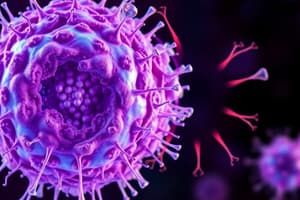Podcast
Questions and Answers
What are the characteristics of prokaryotic cells?
What are the characteristics of prokaryotic cells?
- They have no nuclear membrane, 2) their DNA is not wound around histones, 3) the cell walls are made of a chemical called peptidoglycan, 4) they do not have complex membrane-bound organelles.
What are some characteristics of eukaryotic cells?
What are some characteristics of eukaryotic cells?
- They have a nuclear membrane around their DNA, 2) their DNA is wound around histones, 3) they have complex membrane-bound organelles.
What are the six shapes of prokaryotic and eukaryotic cells?
What are the six shapes of prokaryotic and eukaryotic cells?
- Coccus, 2) Bacillus, 3) Vibrio, 4) Spirillum, 5) Spirochete, 6) Pleomorphism.
What are the five arrangements of prokaryotic and eukaryotic cells?
What are the five arrangements of prokaryotic and eukaryotic cells?
Signup and view all the answers
The majority of gram-positive organisms have which cell wall structure?
The majority of gram-positive organisms have which cell wall structure?
Signup and view all the answers
The majority of gram-negative organisms have which cell wall structure?
The majority of gram-negative organisms have which cell wall structure?
Signup and view all the answers
What do chromatophores do?
What do chromatophores do?
Signup and view all the answers
What are the 5 types of flagella?
What are the 5 types of flagella?
Signup and view all the answers
What does monotrichous mean?
What does monotrichous mean?
Signup and view all the answers
What does amphitrichous mean?
What does amphitrichous mean?
Signup and view all the answers
What does lophotrichous mean?
What does lophotrichous mean?
Signup and view all the answers
What does peritrichous mean?
What does peritrichous mean?
Signup and view all the answers
What does atrichous mean?
What does atrichous mean?
Signup and view all the answers
What is a glycocalyx?
What is a glycocalyx?
Signup and view all the answers
What is a slime layer?
What is a slime layer?
Signup and view all the answers
What is a capsule?
What is a capsule?
Signup and view all the answers
The nucleus contains what?
The nucleus contains what?
Signup and view all the answers
Study Notes
Prokaryotic Cells Characteristics
- Lack a nuclear membrane
- DNA is not associated with histones
- Cell walls predominantly composed of peptidoglycan
- Absence of complex membrane-bound organelles
Eukaryotic Cells Characteristics
- Surrounded by a nuclear membrane encapsulating DNA
- DNA is associated with histones
- Contain complex membrane-bound organelles, enhancing cellular function
Shapes of Prokaryotic and Eukaryotic Cells
- Coccus: spherical shape
- Bacillus: rod-like shape
- Vibrio: comma-shaped
- Spirillum: spiral shape
- Spirochete: flexible spiral shape
- Pleomorphism: variability in shape
Arrangements of Cells
- Diplo: pairs of cells
- Strepto: chains of cells
- Staphylo: clusters of cells
- Tetra: groups of four cells
- Sarcinae: cubic arrangements of eight cells
Gram-Positive Cell Wall Structure
- Characterized by a thick layer of peptidoglycan (Murien)
- Contains trichroic acid and a cell membrane
Gram-Negative Cell Wall Structure
- Comprises a thin layer of peptidoglycan
- Features an outer membrane containing lipopolysaccharides (LPS), which act as endotoxins
Function of Chromatophores
- Responsible for synthesizing pigment colors in certain cells
Types of Flagella
- Monotrichous: single flagellum at one pole
- Amphitrichous: single flagellum at both poles
- Lophotrichous: multiple flagella clustered at one end
- Peritrichous: flagella distributed over the entire surface
- Atrichous: devoid of flagella
Glycocalyx Definition
- A network of carbohydrate-rich molecules coating cell surfaces, aiding in protection and adhesion
Slime Layer Definition
- An unorganized, diffuse layer of polysaccharides and/or proteins outside some bacterial cells
Capsule Definition
- A well-organized, hardened slime layer; important for pathogenic bacteria, such as those causing pneumonia
Nucleus Composition
- Contains DNA, the genetic material essential for cellular function and inheritance
Studying That Suits You
Use AI to generate personalized quizzes and flashcards to suit your learning preferences.
Description
Explore the fundamental differences between prokaryotic and eukaryotic cells. This quiz focuses on their characteristics, including cell structure, DNA organization, and the presence of organelles. Perfect for students studying biology and cell theory.




